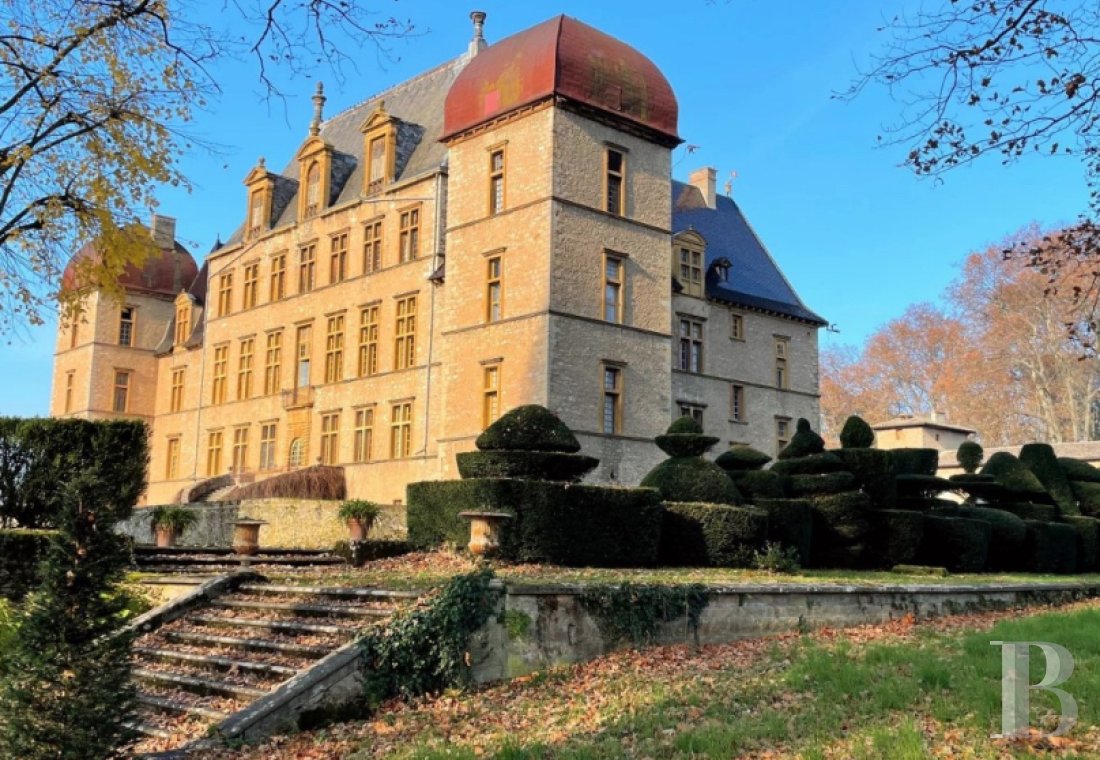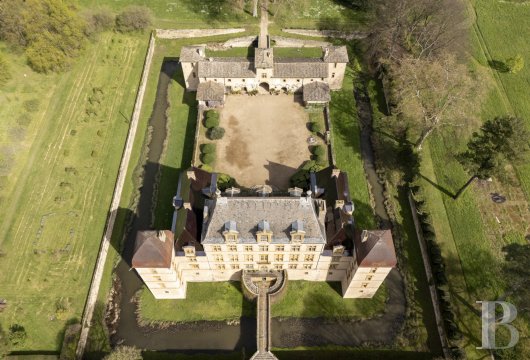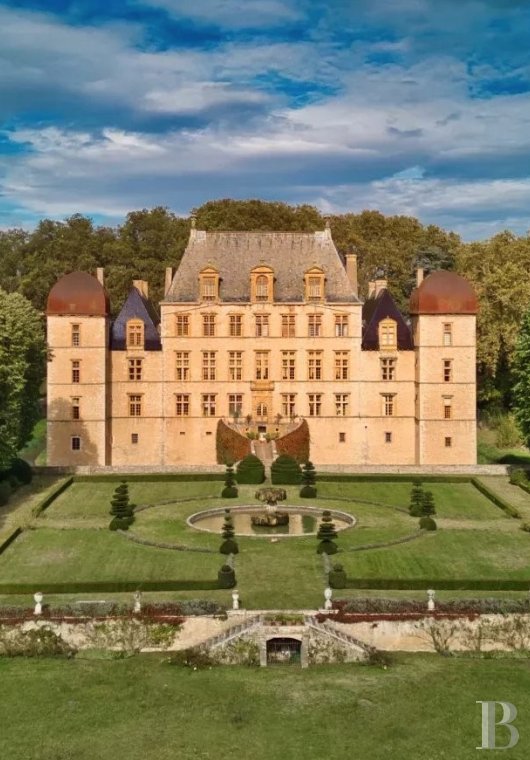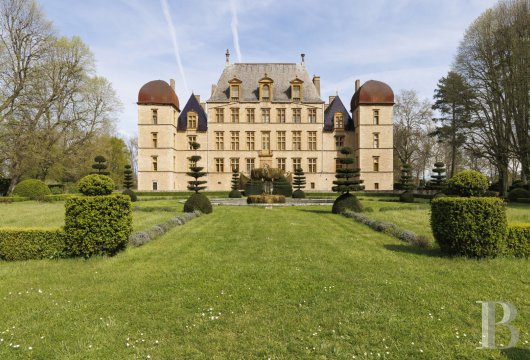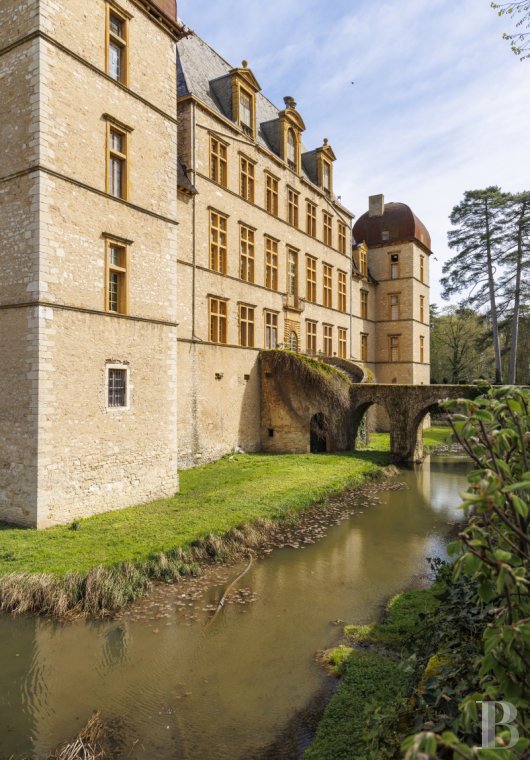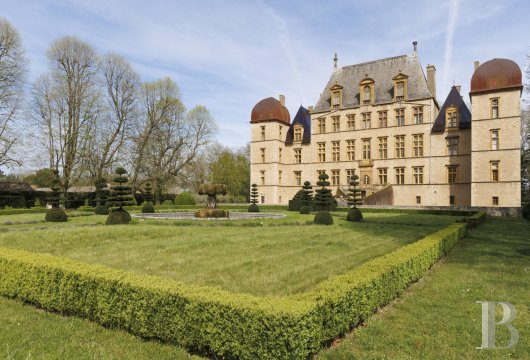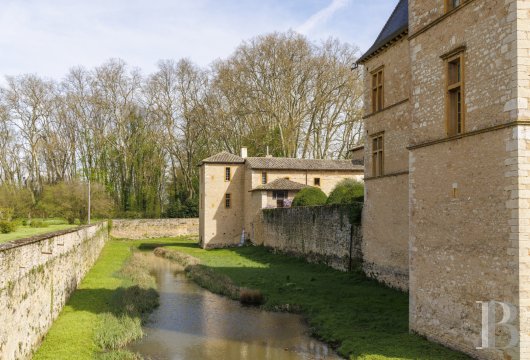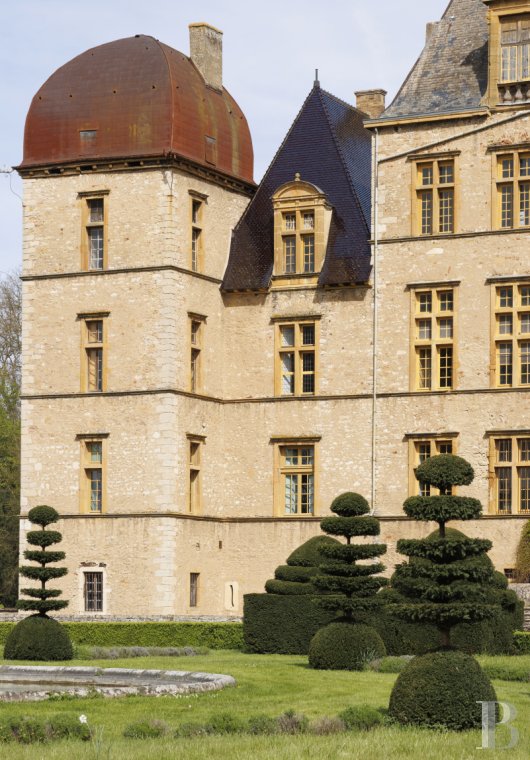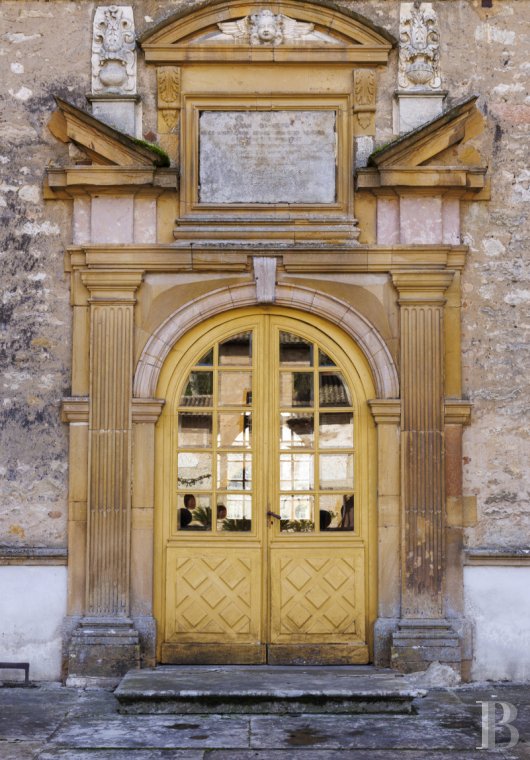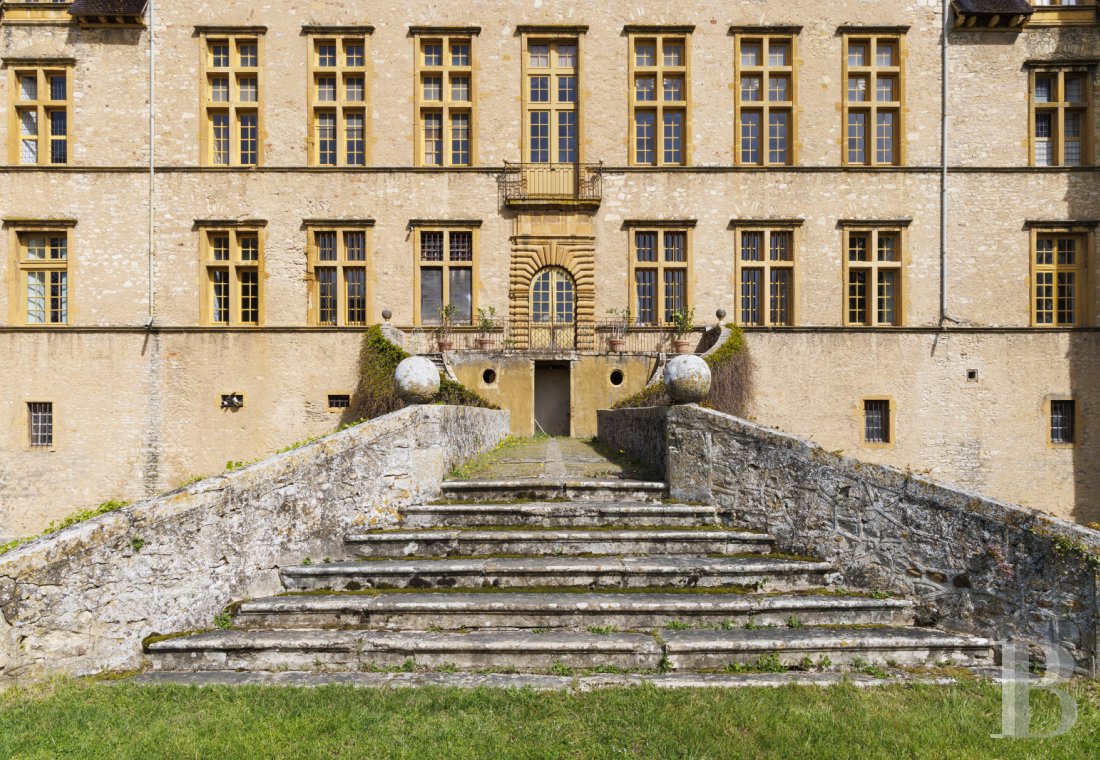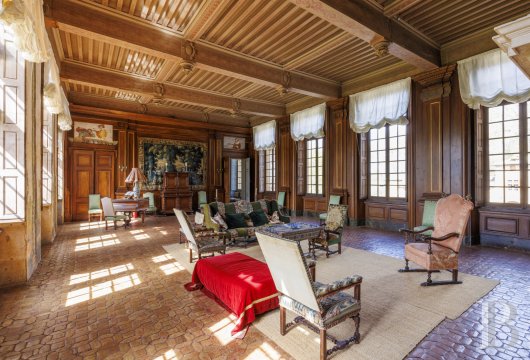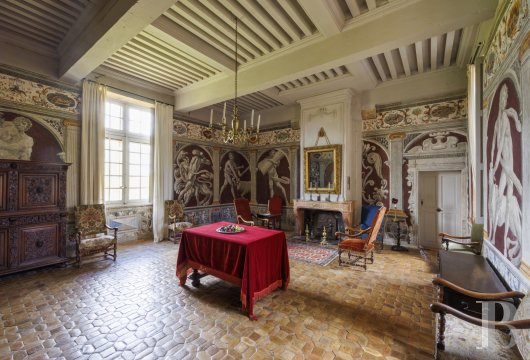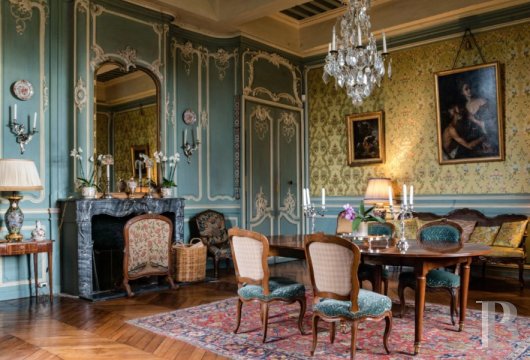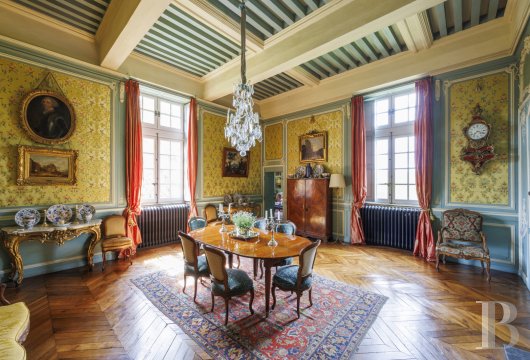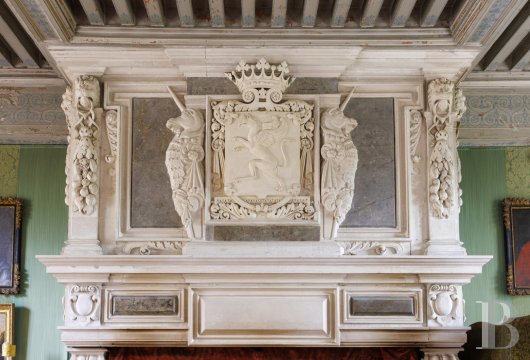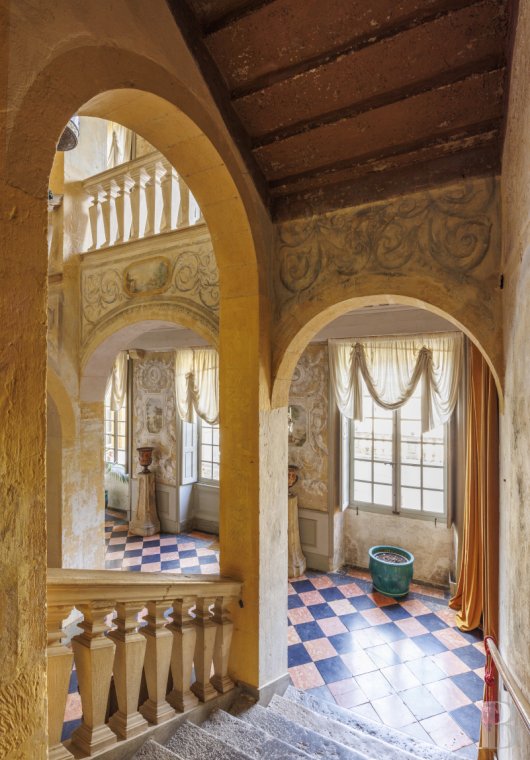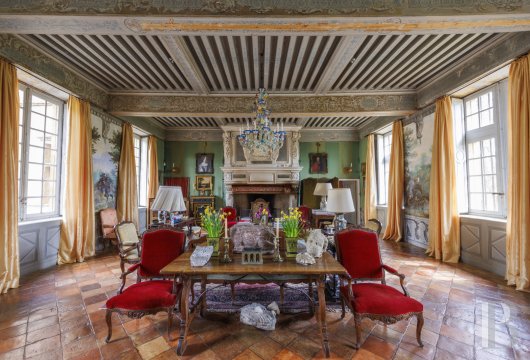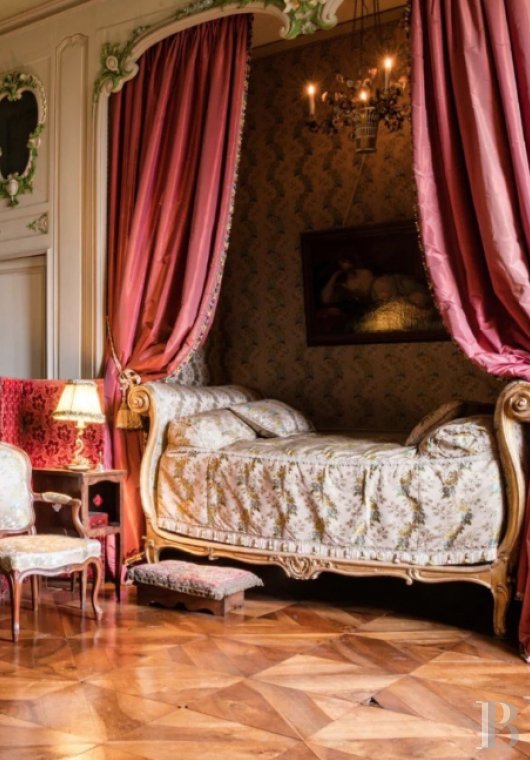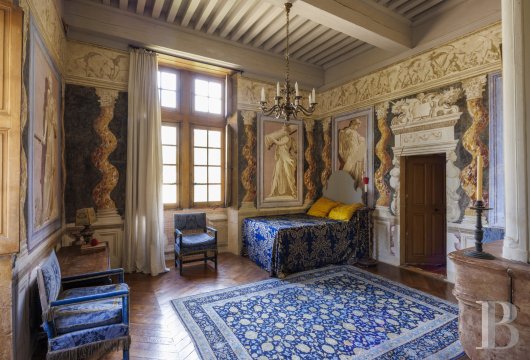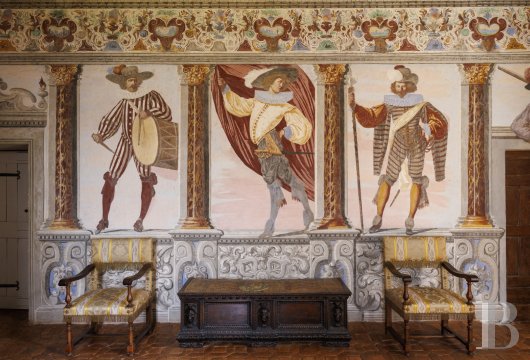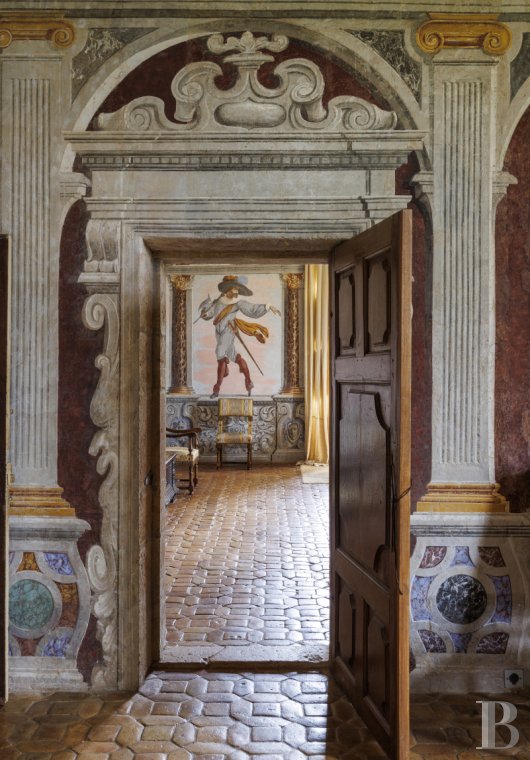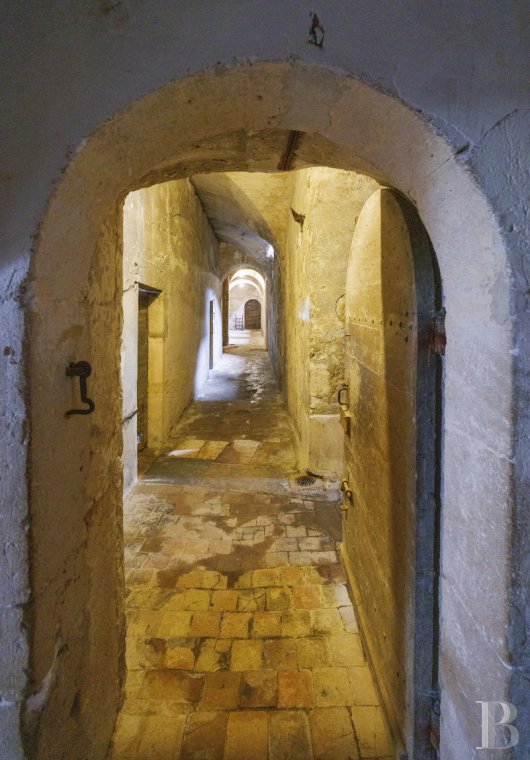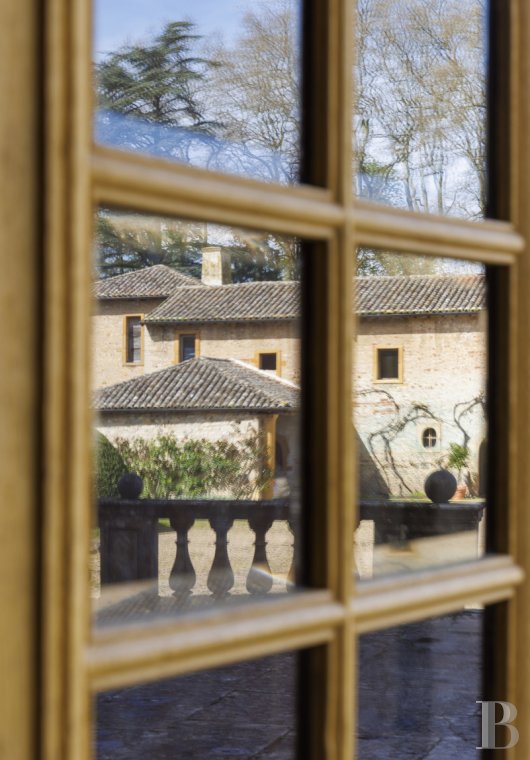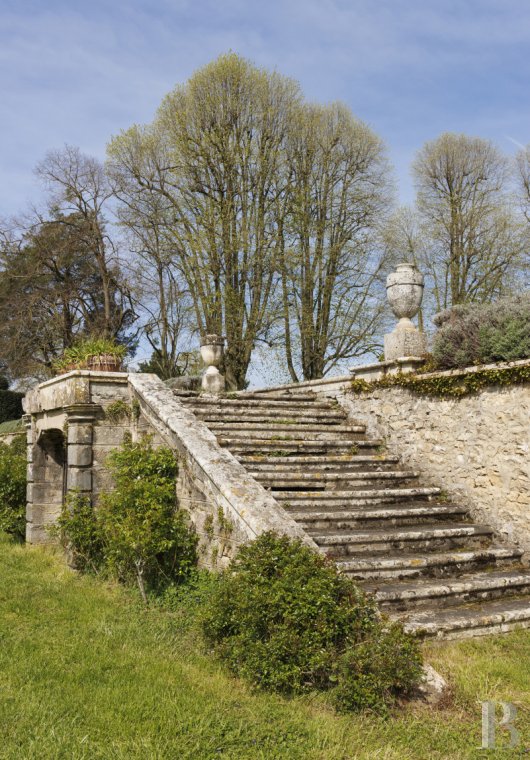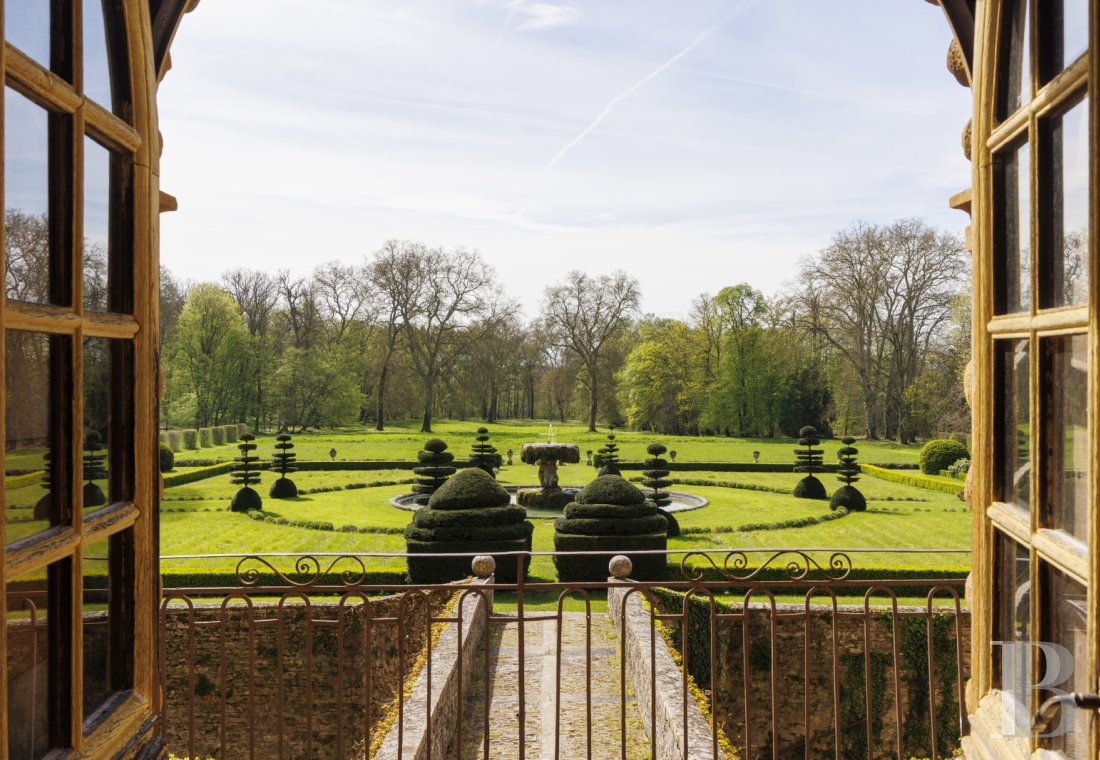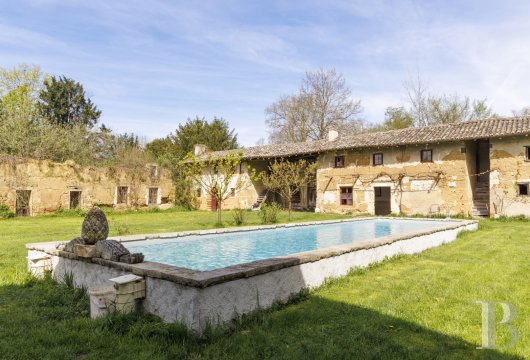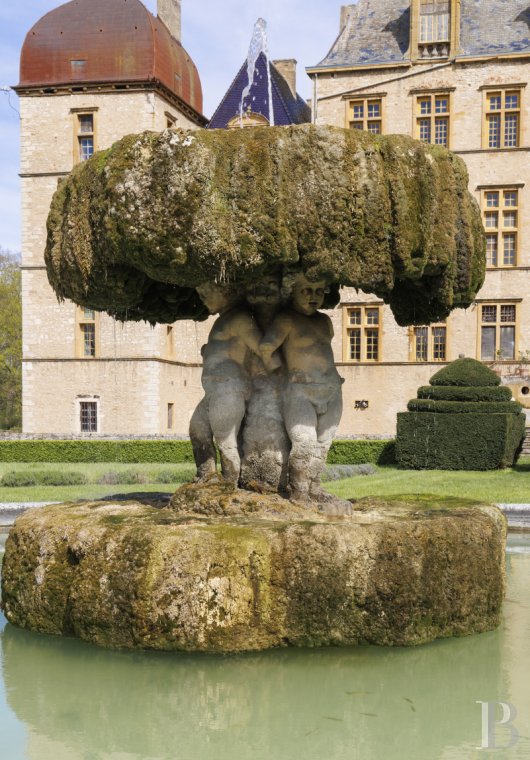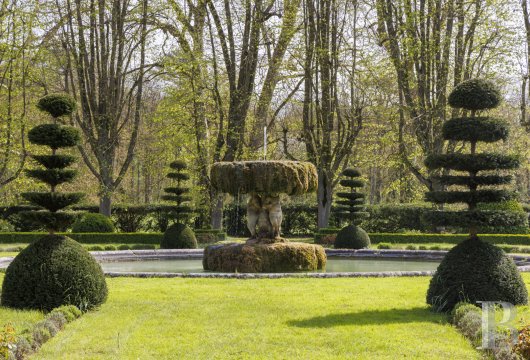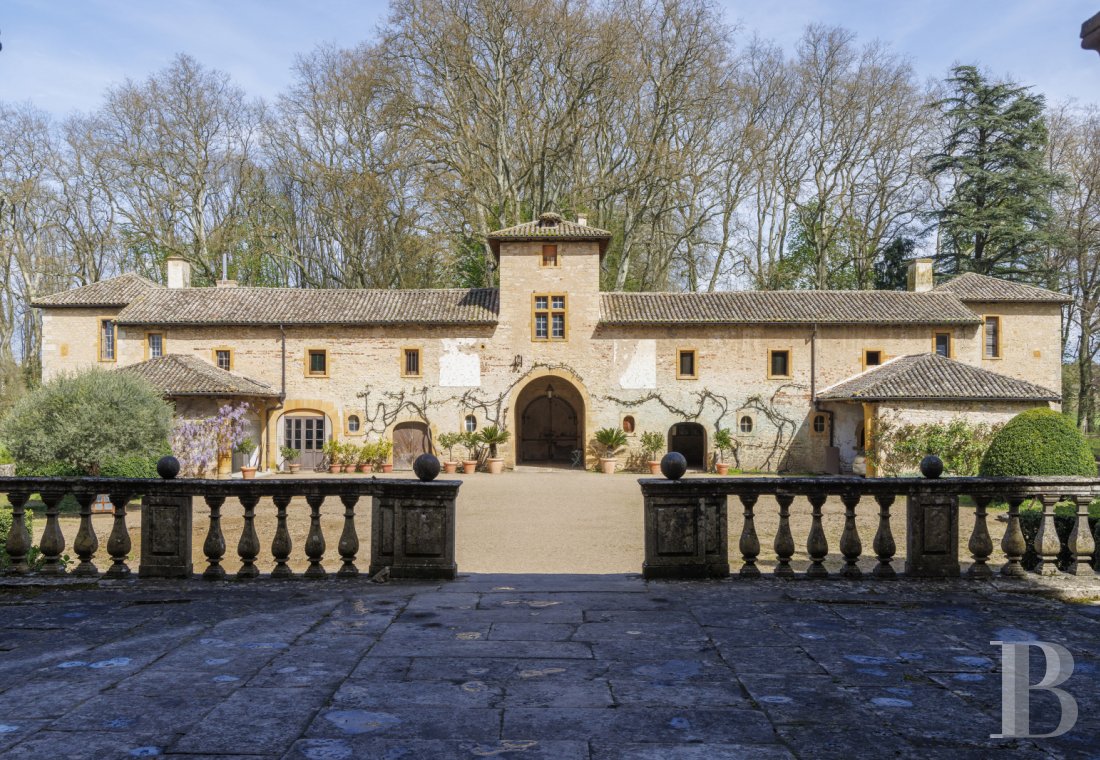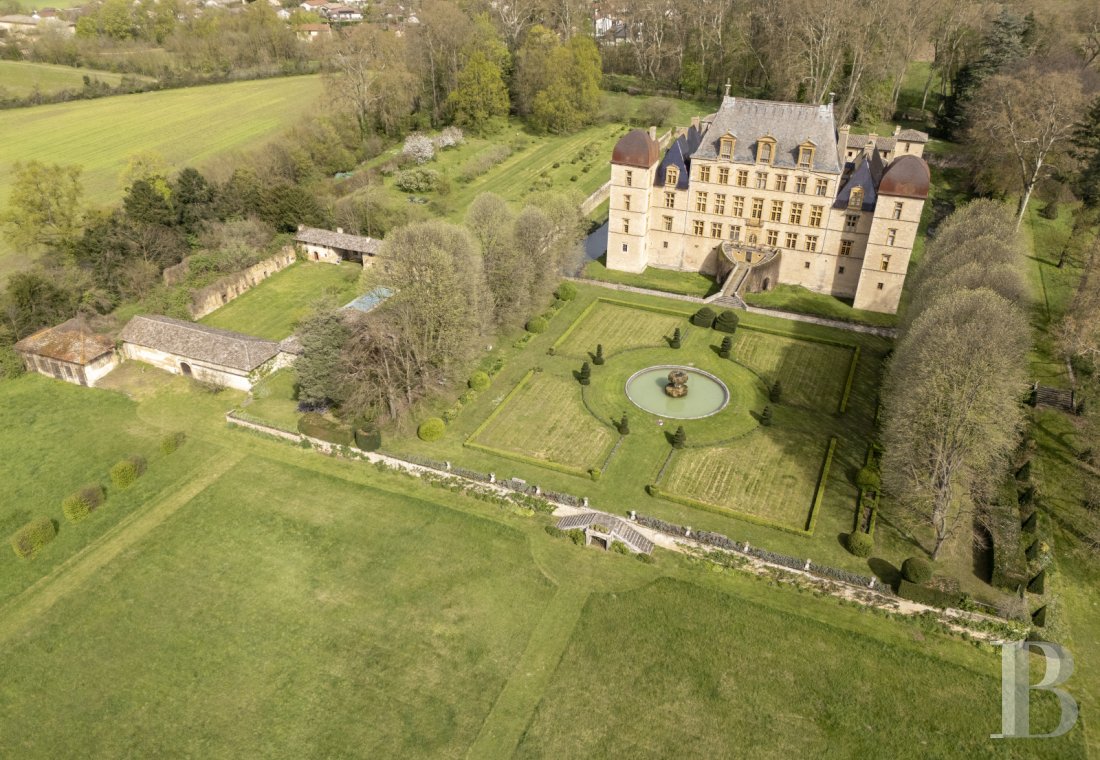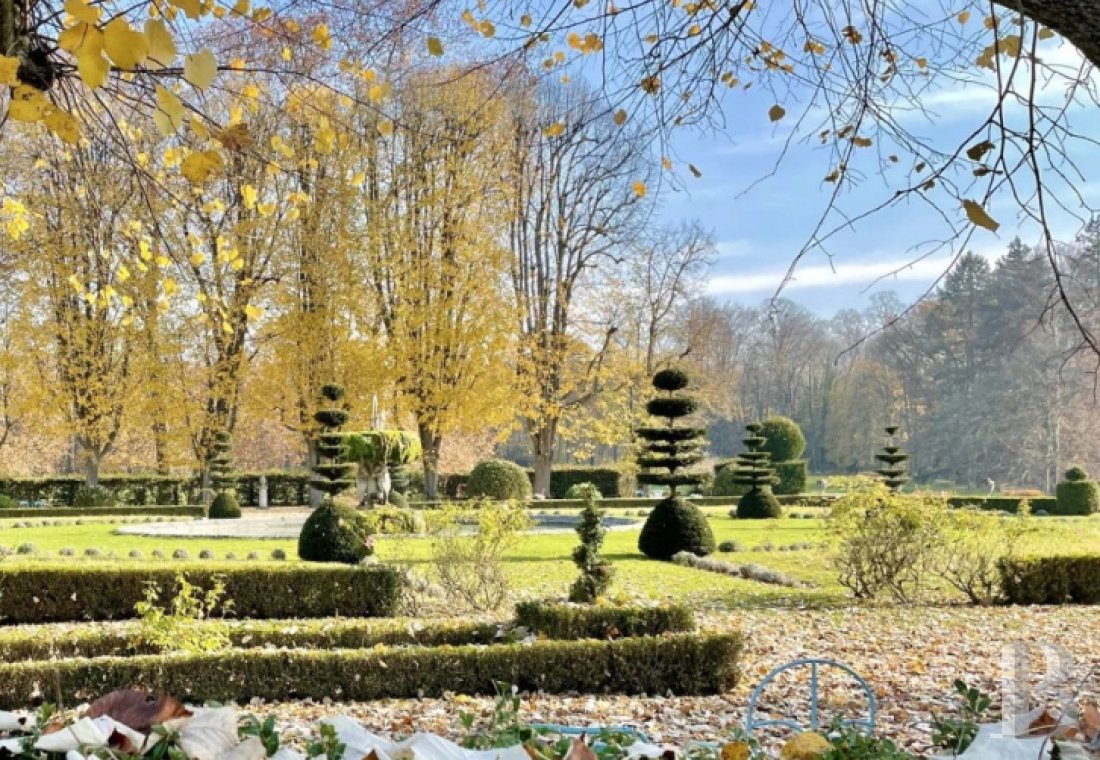Location
Situated in the south-western part of the Ain department, the property is in the Dombes region, on the left bank of the River Saône. It is less than 10 km from Villefranche-sur-Saône - a medium-sized town with shops, services and basic facilities. It takes just 30 minutes to reach the north of Lyon from the property, which is easily accessible by road via the A7 motorway. The Villefranches-sur-Saône train station has trains to Lyon Part-Dieu station taking around 20 minutes, with several services a day. Today, the natural and historical Dombes region has around 1 200 ponds that are maintained and where carp is farmed in accordance with age-old traditions.
Description
The chateau
At the end of the old drawbridge, a porch on the north side reveals a vast inner courtyard. Once you have crossed the courtyard, a flight of steps leads up to a large terrace protected by a balustrade with pear-shaped balusters and a square base, and then to the monumental chateau entrance door. The door, with its semi-circular arch, is flanked on either side by fluted Doric pilasters and surmounted by an engraved plaque, itself topped by an arched pediment adorned with a cupid in bas-relief. Ornaments and sculpted vases follow on from the pilasters. The moat is protected inside and out by rendered stone walls. Finally, at the rear of the chateau, an imposing horseshoe-shaped staircase and an arched bridge spanning the moat lead to the garden and fountain.
The ground floor
The front door opens onto a hall with a black and white checkerboard floor, featuring a large stone staircase with balusters opening onto a central space. This leads to all of the floors. The ground floor is divided into various reception rooms, including lounges. One of the rooms, currently used as a dining room, has parquet flooring and an imposing grey marble fireplace with white veins and carvings, a painted French-style ceiling and high and low Rocaille-style panelling in shades of blue and white, created by Philibert Lonbois of Lyon and silk lampas fabric with its golden yellow background created by the Bucol company. Another lounge with a similar ceiling, decorated with paintings of plant motifs in shades of blue and beige, an antique terracotta floor and beige and light grey base panelling features a monumental fireplace in white limestone and black marble sculpted with a dragon, unicorns and fruit. This is followed by a dining room with a herringbone parquet flooring, a library with parquet flooring and walls covered with high glass shelves in green-painted wood - which can also be used as a smoking room - and finally three bedrooms. One of the rooms, dating from the 18th century, is grey and has a gilded wooden bed with a crossbeam. It adjoins the library; another, in yellow and blue, was created in the tower after the parquet room; the last, in beige and red, has an alcove, frescoes of castles and gardens, and a four-poster bed. Lastly, a shower room and toilet are accessible from the "parquet room", where a remarkable 18th-century star-shaped parquet floor, made up of five wood types, is on display. It came from the Scarron mansion in Lyon and was later found in Belgium before being transferred to the chateau.
The first floor
Here, the space is organised around a large living room, measuring around 130 m², and is made up of seven fairly large rooms, mainly used as bedrooms, a shower room and two bathrooms, as well as a toilet. The first, with its 18th-century high panelling, floor covered in old terracotta tiles and French-style painted wooden ceiling, features a white limestone and black marble fireplace that is remarkable and imposing, with its richly sculpted reliefs of female allegories and angels and its trumeau adorned with a painted allegory of charity. It was here, in the consistory room, that the members of the Sève family settled their civil affairs. As for the bedrooms, most of which have terracotta floors, French-style ceilings and carved stone fireplaces. Each has its own strong aesthetic identity, largely linked to the murals by Pietro Ricchi that cover the walls, a vivid reminder of Italian decorative painting under Louis XIII. It is the largest collection of transalpine frescoes found in France outside the Île-de-France region, and the commission illustrates the Sève family's desire to assert their Italian origins - which was pure wishful thinking. For example, the "parade" shows a parade of figures, including a drummer, a standard-bearer, a halberdier and a musketeer, taken from an engraving depicting a key event in the family's rise to prominence: in 1595, Jean Sève organised the "Grande Entrée" of King Henri IV, whom he had supported, a parade of soldiers and notables in honour of the Bourbon king, and had it depicted here a few years later by the Tuscan painter, inspired by engravings by Goltzius. The walls in the Hercules room show the exploits of the mythological Greek hero in the guise of Henri IV, whose maternal ancestors claimed descent from Heracles, while the perspectives room shows palatial views typical of the Italian Renaissance. Finally, the "Chamber of Virtues", decorated with twisted columns reminiscent of the Temple of Jerusalem, features frescoes of young women, allegories of the four cardinal virtues: Justice, Strength, Temperance and Prudence. The so-called "Louis XIV" bedroom in the east tower stands out with its deep red and gold tones, its four-poster bed, its multicoloured silks and its decorative pilasters in painted and gilded wood.
The second floor
Formerly a temple measuring around 250 m², this part of the building has been divided into utility rooms and other miscellaneous areas, and has yet to be fitted out. Three bedrooms, a kitchen and a shower room are in need of restoration: in particular the terracotta-tiled floors, the French-style ceilings and the wooden balustrade railings that adorn the dwelling formed by these rooms. Scenes from Philippe de Broca's film “Le Diable par la queue" (The Devil by the Tail) were shot on this floor in the late 1960s.
The basement
Accessed from the courtyard via a gentle slope, cellars, a large kitchen, a pantry and a single-room servant’s flat all enjoy plenty of light thanks to the various windows. There are high ceilings and stone or terracotta tiled floors.
The service quarters
Built in a rectangular shape in the inner courtyard to the north, they face the chateau and comprise barns, a workshop, a caretaker's cottage and miscellaneous rooms. Men's and women's toilets and toilets for people with reduced mobility are accessible from the courtyard, which is useful when welcoming the public at weekends and on public holidays. The caretaker's cottage has a living room with a kitchenette, a bedroom and a bathroom. There are large rooms that need fitting out spread across the ground and first floors. The former stables are now used as an exhibition space. Garden tools, planters and other equipment are stored in a space on the ground floor.
The outbuildings
Slightly set apart, these form a walled square with a 15 m x 4 m swimming pool inside. Part of a wall needs to be rebuilt, but authorisation has already been obtained for its reconstruction. The various rooms in the outbuildings need renovation. Below the garden and adjoining the swimming pool, a small courtyard with a terracotta tiled floor is enclosed by walls on two sides and partially planted. Finally, above the arches that form a third side, an Italian-style gallery runs the full length of the building, topped by a three-sided canal tile roof and a terracotta finial.
The grounds
Extending around the chateau, over an area of almost 39 hectares, they were replanted in an English style around 1820. They feature flowerbeds and copses, topiary, lime and oak trees in classical rows and vast expanses of lawn. The majestic 40-metre-high plane trees, the cypress trees around the pond and the lush green pathways make for a remarkably unspoilt promenade. Finally, a fountain with three marmosets from Vaux-le-Vicomte faces the chateau.
Our opinion
A 17th-century chateau that is atypical, with its corner towers and immense Italian frescoes, yet which conveys classical authenticity through its symmetry and characteristic architectural features, all in an exceptional setting, with its moats and 39 hectares of grounds which has been continuously landscaped. The property has been maintained with enthusiasm and self-sacrifice. Work undertaken over 25 years now gives it value and life for the years to come. It will allow future occupants, aware of its riches, to venture into the future with a property whose history is still unfolding. Classification of the building as a historic monument will enable them to continue restoring the structure while linking it to a tourist, artistic or cultural project.
9 600 000 €
Fees at the Vendor’s expense
Reference 665438
| Land registry surface area | 39 ha |
| Main building surface area | 1200 m2 |
| Number of bedrooms | 10 |
NB: The above information is not only the result of our visit to the property; it is also based on information provided by the current owner. It is by no means comprehensive or strictly accurate especially where surface areas and construction dates are concerned. We cannot, therefore, be held liable for any misrepresentation.


